Steve Ruffin
(via Daniel Bastien)
I once knew an old pilot named Floyd Pickrell who had flown in World War I from the « ancien aérodrome » at Remicourt, France.
In early October 1918, the men in his unit—the 50th Aero Squadron—were ordered to locate and drop supplies to a group of American soldiers trapped on a hillside in the Argonne Forest. These men became known as the « Lost Battalion, » and the 50th—thanks to its valiant efforts in trying to save them—became the U.S. Air Service « Medal of Honor Squadron. »
In 2008, I decided to travel to France to locate this little-known but historically significant aerodrome from which the 50th Aero flew in 1918. First, I had to determine the correct town, since there are at least two in France with the name « Remicourt. » I quickly established that the one from which the 50th operated is located in the Marne department about 30 km northwest of Bar-le-Duc at 48°57′07″N 4°52′33″E.
Based on a description Floyd had given me many years ago, I eventually found where the aerodrome was in relation to the town. As he described it:
Remicourt was east of our field, not far—and if it is still there, a small lake [Étang d’Oie] was located just to the northeast of our field. In that lake was a panel which we were told to shoot at for target practice. On the south side of our field was a road going to Remicourt…. And there’s where we started operations on September 26, 1918.
This big, flat field is situated about 2 km west of Remicourt on the north side of the D54 Remicourt-Noirlieu road. In October 1918, it was some 30 km south of where the Meuse-Argonne Offensive was raging. During this battle, the sprawling aerodrome was occupied by the U.S. Air Service 1st, 12th, and 50th Aero Squadrons and French Escadrille Br.211. These four units comprised the 1st Corps Observation Group.
The observation squadrons flying from Remicourt were the « eyes and ears » of the generals directing the Meuse-Argonne Offensive. Here, more than a million U.S. and French troops actively engaged the still-powerful German army in a desperate struggle that would finally bring an end to the war. During these operations, Allied airmen repeatedly flew into hostile territory in the worst possible weather conditions to support the troops on the ground.
On 6 October 1918, one of these missions was assigned to 50th Aero Squadron Lieutenant Harold E. Goettler and his observer, Lieutenant Erwin R. Bleckley. They and the other airmen of the 50th were tasked with locating and dropping supplies to the men of the 77th Division’s so-called « Lost Battalion. » This ill-fated group of doughboys had advanced deep into the Argonne Forest ahead of their flanking units and become surrounded by an aggressive and well-armed enemy. They were trapped on the steep northern slope of a deep ravine 2 km northeast of Binarville. Here, they were being slowly annihilated.
In the late afternoon of 6 October, Lieutenants Goettler and Bleckley took off from Remicourt in DeHavilland DH-4 Liberty Plane No. 32517, bearing a big red « 6. » It was their second sortie of the day in support of the Lost Battalion. Determined to accomplish their objective, they flew repeatedly down into the ravine where the men were trapped, trying to pinpoint their location so they could drop bags of vital supplies to them. All the while, their airplane was being shot to pieces by enemy groundfire coming from all directions—including from above, on the bluff that towered over the ravine. Undeterred, the two airmen continued their methodical search for an agonizing 20 minutes.
Inevitably, the valiant attempt ended in tragedy when pilot Goettler received a fatal bullet wound to the head. The big biplane crashed about 200 meters southwest of Binarville. Goettler was already dead, while Bleckley died soon after being violently thrown clear of the crash. For their heroic efforts, they were accorded America’s highest award for valor, the Medal of Honor. Only two other U.S. Army airmen in the First World War—renowned aces Frank Luke and Eddie Rickenbacker—received this coveted medal.
The Commemoration
There were no markers to identify the Remicourt aerodrome or honor the brave airmen who had flown from there, so I joined forces with my good friend, Jerry Hester, to correct this. Over the next year, Jerry, who later became a member of the U.S. World War I Centennial Commission, made all the necessary arrangements. He designed and ordered a beautiful bronze marker to be placed in Remicourt, and he organized a series of events for 6 and 7 October 2009.
More than 200 people—including dignitaries, guests, and military members from France, Germany, and the U.S.—congregated in the small towns of Binarville and Remicourt. They came not only to memorialize the heroism of Medal of Honor airmen Goettler and Bleckley, but to pay tribute to all the American airmen who had served in France.
On the morning of 6 October, Mrs. Nancy Erwin and Mrs. Joan Starr, nieces of Lts. Bleckley and Goettler, respectively, joined us at the Meuse-Argonne American Cemetery to pay their respects at Bleckley’s grave. Mrs. Starr was accompanied by her two sons, Jeffrey and David, and Mrs. Erwin by her husband, retired U.S. Air Force Major General Ralph D. Erwin. Joining this group at Bleckley’s graveside were members of the Kansas and Illinois National Guard, to represent Bleckley and Goettler’s home states.
We then proceeded to the site of the Lost Battalion in the Argonne Forest, where we met citizens of the town of Binarville for a ceremony at the beautiful new Lost Battalion Memorial Monument. Here, a bugler sounded Taps and wreaths were placed by representatives of the town, the U.S. military, and the respective families. The generous and patriotic citizens of Binarville then hosted an elaborate reception at the Mairie with champagne and hors d’oeuvres.
Before leaving Binarville, we placed a memorial wreath near the site where Goettler and Bleckley’s aircraft had crashed. I had previously determined the crash location on the southwest outskirts of Binarville from a description and hand-drawn map provided by an American ambulance driver who witnessed the crash. He had shared this information in a 1920 letter to one of the former pilots of the 50th Aero Squadron.
That evening, Remicourt Mayor M. Ghislain Deketele hosted a dinner at the Givry-en-Argonne restaurant Grain-de-Sel. In attendance among the 50 guests were members of the local town councils and other dignitaries. The food and drink were excellent, as was the wonderful camaraderie.
On the next morning, 7 October—a bright, warm, and sunny day—the formal dedication ceremony was held at 11:00 in front of the Mairie at Remicourt. This was the 91st anniversary of the day that 50th Aero Squadron pilot/observer Lts. Robert M. Anderson and Woodville J. Rogers finally located and reported the correct position of the Lost Battalion. Some 200 spectators, TV news crews, and other members of the press looked on, as honor guards presented the French and American colors to the sound of the respective national anthems and a French military bugle corps.
As I watched and took photographs, Jerry conducted the ceremony. He was assisted by Remicourt resident Alain Deketele. In attendance were Col. Robert Dooley, U.S. Air Attaché, Paris; M. Serge Barcellini, Director of the History Council, Department of the Meuse; M. Ghislain Deketele, Mayor, Remicourt; and Mme Françoise Duchein, Council General, Department of the Marne.
The high point of the ceremony occurred when the bronze plaque was unveiled that memorialized the exploits of the 50th Aero Squadron airmen flying from Remicourt. Wreaths were placed beneath it by representatives of the Goettler and Bleckley families, the town of Remicourt, and the Kansas and Illinois National Guard. Then, in one of the most dramatic moments of the day, M. Guy DeLabare of Remicourt released 50 homing pigeons in memory of all the aviators who gave their lives in WWI. They circled the gathering and then, like the aviators they represented, climbed toward the sky into the brilliant sunshine.
At the close of the ceremony, flamboyant French show-pilot Jack Krine took off in his World War I replica S.E.5 aircraft from the site of the old aerodrome. He then proceeded to perform a thrilling aerobatic display over the town of Remicourt. This display was a fitting finale to the stirring ceremony. Immediately following the flying display, the towns of Remicourt and nearby Givry-en-Argonne hosted a champagne reception for all attendees of the ceremony.
The event received widespread French and American press coverage and it prompted the American Battle Monument Commission to add Remicourt to its list of American WWI sites in the Meuse-Argonne region.
Since the Remicourt dedication, many similar tributes honoring America’s World War I presence have been held throughout France. They help preserve the memory of the Americans who served there during World War I. But equally important, they reinforce the strong bond of friendship that continues to exist today between our two countries.
On 6 October 2018, ceremonies were held in Wichita, Kansas, and Chicago, Illinois, to once again honor the memory of Lieutenants Goettler and Bleckley. Our country is indebted to these two heroes who sacrificed their lives 100 years ago for their comrades on the ground.
Prepared for Anciens Aérodromes by Steven A. Ruffin
Steven A. Ruffin is an aviation author who has written and published three books, the most recent of which is a photographic history of the Lafayette Escadrille. Readers with questions or comments about this article, or any other aspect of aviation history, are encouraged to email him at saruffin@aol.com.
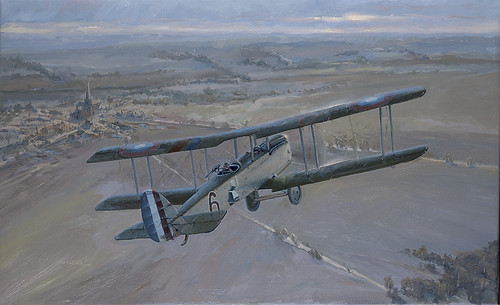
The somber Mike O’Neal painting Mortal-Immortal depicts the final mortal moments of 50th Aero Squadron pilot/observer Lts. Harold E. Goettler and Erwin R. Bleckley, as they enter their final approach to immortality. Both died on 6 October 1918 during their second attempt of the day to locate the men of the « Lost Battalion. » Seconds after pilot Goettler was mortally wounded, the DeHavilland DH-4 Liberty Plane plunged into an open field in the French lines, 200 meters southwest of Binarville. Bleckley died soon afterward from injuries received in the crash. Both men were posthumously awarded the Medal of Honor. They are two of only four U.S. Army Air Service airmen in WWI to receive America’s highest military award for valor. (courtesy Mike O’Neal)
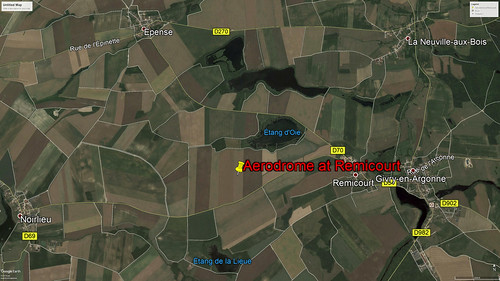
The Aerodrome at Remicourt (Marne) was located 2 km west of town, on the north side of the D54 Remicourt-Noirlieu road, and some 30 km south of the ravine where the men of the Lost Battalion were trapped.
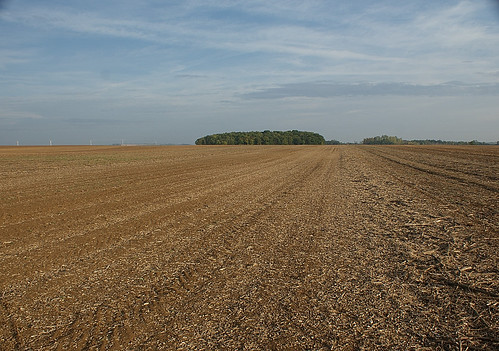
The site of the Remicourt aerodrome, looking north from the D54 Remicourt-Noirlieu road. The small lake that former 50th Aero Squadron pilot Floyd Pickrell described, Étang d’Oie, is located beyond and to the right of the tree line. (Steve Ruffin)
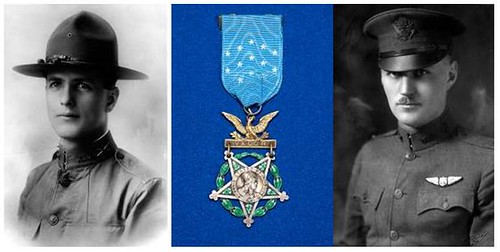
U.S. Air Service 50th Aero Squadron Medal of Honor Airmen, Lieutenants Erwin Bleckley (left) and Harold Goettler. (U.S. Air Force)
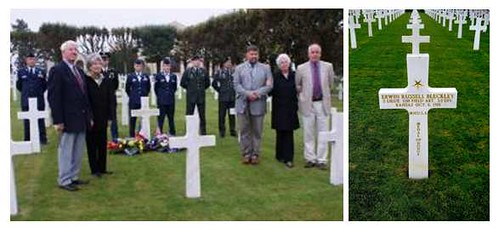
Family members of Lts. Harold E. Goettler and Erwin R. Bleckley pay tribute to Bleckley at his grave at the Meuse-Argonne American Cemetery, Romagne, France. The memorial took place on 6 October 2009, the 91st anniversary of Goettler and Bleckley’s heroic Medal of Honor mission, during which both men died. In the left foreground is Bleckley’s niece, Nancy Erwin, joined by her husband, U.S. Air Force retired Major General Ralph D. Erwin. In the right foreground is Goettler’s niece, Joan Starr. She is flanked by her sons Jeffrey and David. In the background are members of the Kansas and Illinois Air National Guard. (Steve Ruffin)
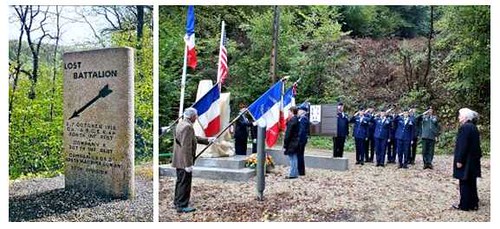
The 6 October 2009 ceremony at the Lost Battalion Memorial Monument. It is located on D66, about 600 meters west of the older marker seen on the left. (Steve Ruffin)
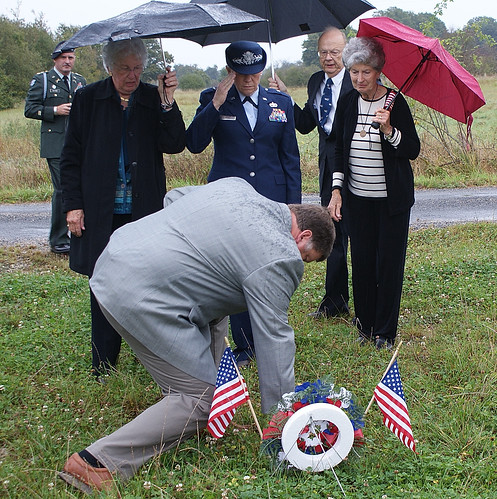
Jerry Hester joins Joan Starr (left), Kansas Deputy Adjutant General Deborah Rose, Nancy Erwin (right), and Jeffrey Starr (kneeling) in paying tribute to Lieutenants Goettler and Bleckley near the site of their crash, on the outskirts of Binarville. (Steve Ruffin)
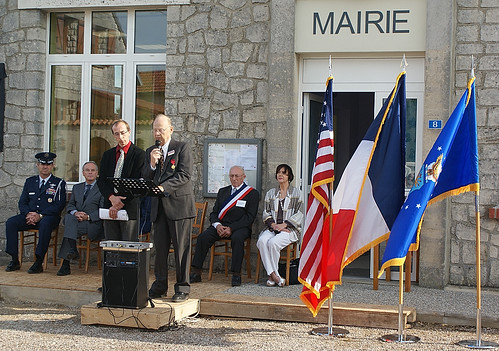
Jerry Hester, assisted by Remicourt resident Alain Deketele, conducts the commemoration ceremony at Remicourt on 7 October 2009. Behind them, from left to right, are Col. Robert Dooley, U.S. Air Attaché, Paris; M. Serge Barcellini, Director of the History Council, Department of the Meuse; Remicourt Mayor M. Ghislain Deketele; and Mme Françoise Duchein, Council General, Department of the Marne. More than 200 people attended the ceremony. (Steve Ruffin)
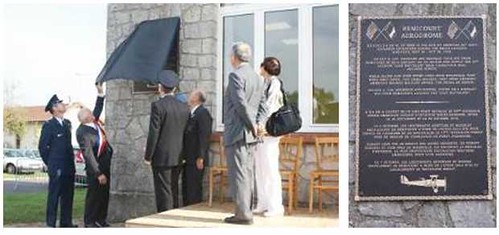
The unveiling of the bronze memorial at the Remicourt Mairie on 7 October 2009. Remicourt Mayor M. Ghislain Deketele and Jerry Hester, do the honors while the other dignitaries look on. (Steve Ruffin)
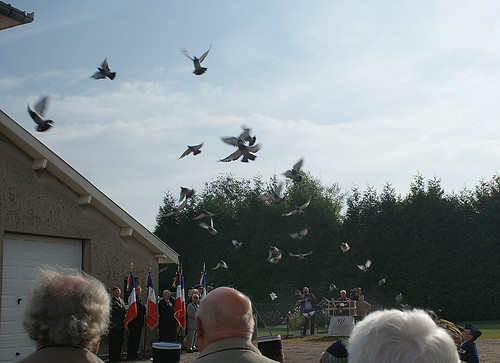
The ceremonial release of 50 pigeons by Remicourt resident, M. Guy DeLabare, to honor all the airmen who died in WWI, provided a stirring conclusion to the ceremony. (Steve Ruffin)
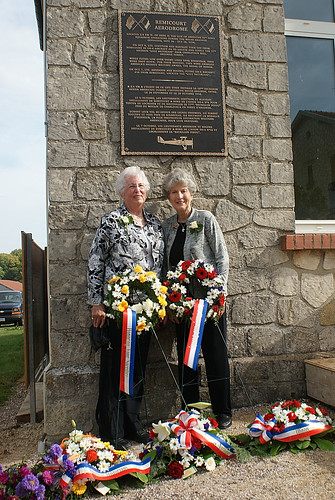
Joan Starr (left) and Nancy Erwin, nieces of Lts. Goettler and Bleckley, pose before the newly unveiled bronze plaque honoring the men of the 50th Aero Squadron. (Steve Ruffin)
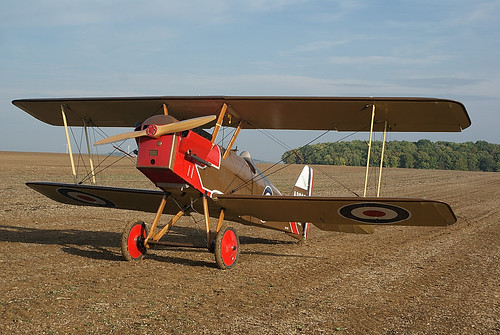
Possibly for the first time since 1918, a biplane sits on the site of the Remicourt aerodrome. This is the replica World War I S.E.5 flown by French air show pilot Jack Krine. He took off from here to perform an aerobatic display over Remicourt after the 7 October 2009 commemoration ceremony. (Steve Ruffin)
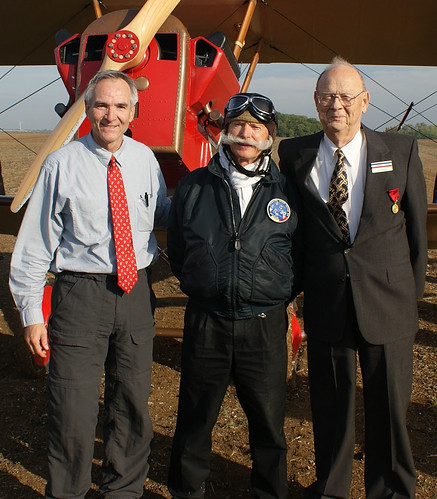
Steve Ruffin (left), Jack Krine, and Jerry Hester at the site of the Remicourt aerodrome. (Steve Ruffin)
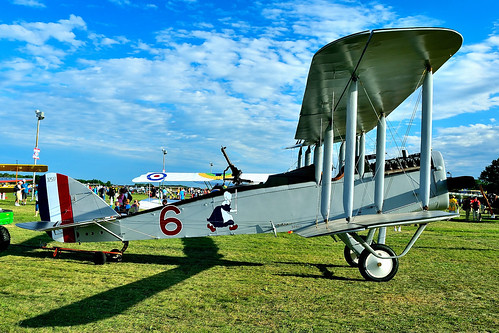
This DeHavilland DH-4 Liberty Plane was recently restored by Dorian Walker and his team, of Bowling Green, Kentucky. It is fully airworthy with an original 400 h.p. Liberty engine, and it is painted in the colors of the aircraft in which Medal of Honor airmen Goettler and Bleckley flew their last mission. (Steve Ruffin)

